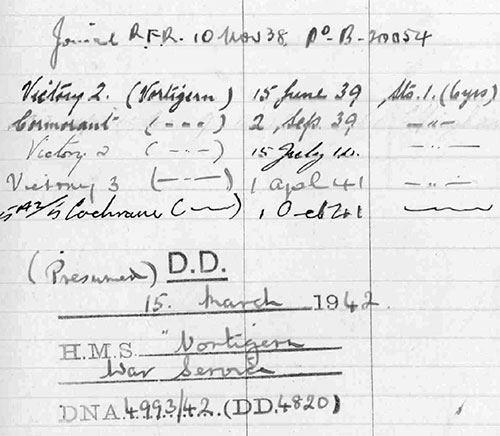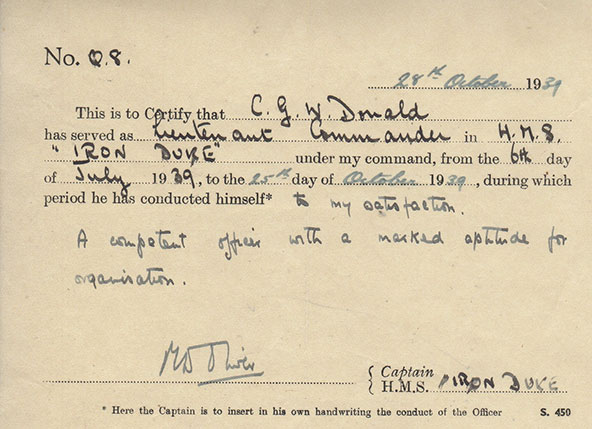
 Obtaining Service Records
Obtaining Service RecordsFor officers and ratings in the Royal Navy, the Royal Navy Reserve and the RNVR

 Obtaining Service Records
Obtaining Service RecordsService records are confusing and
difficult to interpret but are the key to researching the story of
family members who served in the Navy as a rating or an officer. They are restricted to close family members until 116
years after birth when they are transferred to The National Archives
and made avaliable to everybody.
Capital ships of the Royal Navy, the cruisers and battleships, were
"self-accounting". The ships' Writers updated the Service Certificates for
the men and the Pay and Victualing Ledgers for the ship. The
names of men joining and leaving the ship, going on leave,
returning from leave, changing messes, becoming entitled to a "tot" of
rum and anything that could effect the numbers being fed on a
particular day were recorded in the ledgers. In smaller ships including
destroyers the ledgers and service certificates known as "central
record cards" were held by the "depot" at the
naval base. The name of the shore base where these records were held
appeared on a man's Service Certificate followed by the name of his
ship in brackets. The date he joined and the date he left was recorded
alongside.
To find out more about the work of ship's writers on larger "self accounting" ships read the entry for PO Robert Reid "Bob" Campbell, Ship's writer (C/MX 64730) in the destroyer depot ship HMS Hecla, who
left her at Simons Town before she was torpedoed and sunk off the coast
of Morocco on 12 November 1942. Sue Pass, Head of the Naval
Record Office. had this to say: "As we often say in the department Navy
is not 'navy' it’s often grey due to the complicated way it is record
wise".
Service Records of Ratings and Petty Officers (PO)
Ratings
held a personal copy of their record card which recorded the name of
the accounting base (with the name of his ship in brackets) and reports
on his performance by the commanding officer. In the example below,
Stoker 1st Class Thomas William Charles Tweedy (P/KX 77368) served in
HMS Vortigern from 15 June
1939 until 15 March 1942 but the naval base where the ships records
were kept changed several times and when his ship was sunk and his body
was not recovered he was "(presumed) DD" (discharged dead).


Service records are as dry as dust but they tell a story if you learn to read it
Left: Crop from the service record of Stoker Thomas Tweedy
Right: Flimsy of Lt Cdr C.G.W. Donald RN killed by a sniper six months later on 23 May 1940
Service Records of Officers
The
service records of officers from the most junior Midshipman to the
Commanding Officer were not held aboard ship but retained by the
Admiralty. When an officer left a ship or the CO changed the officer
would receive a personal copy of the CO's Officer's Fitness Report
(Form S206) on his performance sent to the Admiralty. A standard entry
might read performed "to my entire satisfaction". These reports known
as "flimsies" are frequently found amongst a retired officers papers
after his death but his family can follow the same procedure for
ratings (see below) to obtain a copy of his full service record. Six months after leaving HMS Iron Duke Lt Cdr C.G.W. Donald RN was shot dead by a sniper at Boulogne on the bridge of his first command HMS Vimy.
The ships in which an officer served can also be traced through his
entries in the quarterly Naval Lists and along with other sources are
used by the Dutch researcher Hans Houterman to create his online
directory of the naval service of officers on www.unithistories.com
Download records from the National Archives
Further details are given on this page: https://www.apply-deceased-military-record.service.gov.uk/essential-information
To apply online, you need a:
digital copy of the death certificate of the
person you’re requesting the records of in the correct format (PDF, JPG
or PNG)
debit or credit card
Your request will be forwarded to Restore Records Management who will carry out a search and e-mail you the record.
All the surviving Pay and Victualing Ledgers and the Central Record Cards are held by the Navy Records Office of Restore Records Management at Swadlincote, South Derbyshire. Restore Records have a contract from the Ministry of Defence to supply copies of service certificates to the next of kin of officers and men. When the original no longer exists they can be reconstructed from the ledgers for the ships in which the man served. This is a lengthy and time consuming task for which a standard fee of £30 is charged. It will readily be appreciated that these ledgers may contain errors or gaps but, strangely, they may also contain details of ships not listed on the original service certificate, especially when a man is only briefly aboard while "taking passage" to join a new ship. Restore Records supply copies of central record cards with a brief guide to the information given on them which can be downloaded as a PDF.
Postal applications for Service Records
Ship's Company
It
would be possible to create a list of all the officers and men aboard a
ship when she was sunk from the Pay and Victualing Ledgers and until a
few years ago
this was done. It took a long time and was very expensive and the
service has been discontinued, on the grounds that applications had to
be processed through Freedom of Information (FOI) mechanisms. I
commissioned three lists for HMS Venomous, the V & W in which my father served, and in 2010 and 2017 published a "ship biography" of Venomous written by Bob Moore and John Rodgaard.
Copies of the crew lists of V & W Class destroyers created before this service was discontinued can be obtained from Restore Records on payment of the standard £30 fee set by the Admiralty. They include crew lists for HMS Wakeful and HMS Wryneck on the dates they sunk. Casualty Lists of the Royal Navy and Dominion Navies researched and compiled by Don Kindell can be seen on naval-history.net and the names of men who died with their next of kin can can also be found on the website of the Commonwealth War Graves Commission but lists of survivors compiled at the time were not retained.